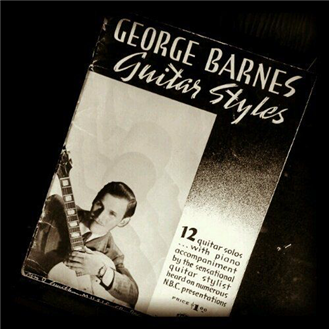Guitar by Randy Buckner
George Barnes “Guitar Style” ~ 1942
Wednesday, September 11, 2019 by Randy Buckner | Method Books
The Book
George Barnes Guitar Styles. Published by William J. Smith: NYC. 39 pages. Copyright 1942. Original cost: $1.00.
Price on eBay or Amazon: good luck finding a copy.
"12 guitar solos - with piano accompaniment - by the sensational guitar stylist heard on numerous NBC presentations."
The Cover
As you can see from the photo, the cover graphics are in the classic late-1930s style I love so well.
The back cover advertises about ten method books, of which Roy Smeck is the only musician I've heard about.
Inside the back cover is an ad for the "George Barnes Guitar Styles" book, Barnes' method book, and a Barnes book titled "Swing Airs."
The last book is an ensemble book with a solo guitar, tenor sax, Bb clarinet, and rhythm section instrumentation. The songs come from the "Guitar Styles" book. I'd like to find that one!!
At the bottom of the page, is a picture of the George Barnes signature pick. It's an extra-heavy tortoise shell pick, which could bought for 1 @ 10¢ or 3 @ 25¢.
Note: because the "George Barnes Guitar Method" was copyrighted in 1943, I think my copy of "Guitar Styles" is a later printing.
From the Forward
The publisher wrote: "Recognized as one of the best amplified guitar artists on the networks... If [George Barnes] keeps going at his present rate, he'll develop into the greatest amplified guitar wizard of all time."
The forward closes with "Barnes is currently working on a method book, and a concerto for guitar; both to be published within a year."
Bio
George Barnes was born 1921 in Chicago, and died 1977 in San Francisco. He started playing the piano at five, but when it was sold to pay for groceries, he switched to guitar. Barnes became a professional musician at twelve, and five years later joined the NBC staff orchestra in Chicago.
In the 1930s, Barnes recorded with such blues artists as Lonnie Johnson, and Big Bill Broonzy. He also worked and recorded with Jimmy Noone, a major musical influence on Barnes.
After working in intelligence during WWII, Barnes resumed his career in Chicago. In the early 1950s, he moved to New York and became one of the most recorded session guitarists of the '50s and '60s. Barnes also signed with Decca, and recorded many solo albums; displaying his genius at arranging, composing, and performing great ensemble music.
In the 1960s and '70s, Barnes performed in duet settings with first, Carl Kress, then Bucky Pizzarelli. He also performed and recorded with Ruby Braff, and Joe Venuti.
In 1977, George Barnes died suddenly, at fifty-six, of a massive heart attack, after changing the strings on his guitar.
What's Inside
I've owned this book for more than thirty years, and it's one of the jewels of my collection. How Barnes was able to write such an advanced book on solo jazz guitar in 1942, is beyond me. At the age of twenty-one, no less.
The style of the songs are exactly like Barnes' guitar work with his late 1940s octet, as well as his mature style later in life.
Granted, the one technique missing in these songs is his skillful, and tasteful, use of bends. However, everything else is here: his inventive use of slides, trills, string skipping, and slurs.
For example, in measures five and six of "Shortin' Bread," Barnes wrote a slide, on the sixth string, which starts on F, ascends to Bb, and then on to G; similar to how a trombonist would play a slide. A very cool sound.
In all of the songs, George skillfully mixed triads with large interval leaps - 7ths and 9ths - and very interesting chord changes. For example: F7-A7-Dm-Dbm6-Bm6-Bbm6-A7-Dm.
I really like Barnes' use of double stops. He wrote them in 3rds, 4ths, 5ths, and 6ths. While playing the arrangements, I heard where Chet Atkins' use of double stops was influenced by Barnes.
All-in-all, these are twelve excellent, and gig-ready, songs worth analyzing and learning.
Final Thoughts
This book is the one to get if
A: you want to learn George Barnes' style.
B: you want to learn a swing guitar style different from Charlie Christian, Les Paul, Oscar Moore, etc.
C: you want to add some awesome guitar licks to your collection.
D: All of the above.
Barnes is becoming more well-known today, thanks to the internet, and especially his daughter, Alexandra Barnes Leh. She has some very interesting projects in the works that you don’t want to miss out on. While you can locate Barnes’ recordings on the internet, your best resource for all things George Barnes is here: The George Barnes Legacy Collection Website
His music is very enjoyable, it swings hard, and you can hear the influence of George's heroes in his playing: Jimmy Noone, Lonnie Johnson, Louis Armstrong, and Bix Beiderbecke.
If you're a student, or performer, of swing guitar jazz, you really should become better acquainted with George Barnes.
Until next time ~
Randy Buckner: Hoover Music Co., Springfield, Mo.
www.bucknerguitar.us


